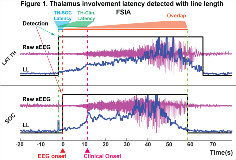Temporal Trends and Predictors of Thalamic Recruitment in Human Focal Epilepsy
Abstract number :
3.071
Submission category :
2. Translational Research / 2A. Human Studies
Year :
2018
Submission ID :
502069
Source :
www.aesnet.org
Presentation date :
12/3/2018 1:55:12 PM
Published date :
Nov 5, 2018, 18:00 PM
Authors :
Emilia Toth, University of Alabama at Birmingham; Diana Pizarro, University of Alabama at Birmingham; Ioannis Vlachos, Louisiana Tech University; Adeel Ilyas, University of Alabama at Birmingham; Andrew Romeo, University of Alabama at Birmingham; Kristen
Rationale: Thalamus, with its reciprocal connectivity to the cortex, plays a critical role in the generation and behavioral expression of focal seizures. Thalamic subnuclei have distinct connectivity patterns with the cortex and determine variable functional significance. A recent study has demonstrated ventral posteromedial nuclei (VPM) interrupted information flow causing altered consciousness, while anterior thalamus (ATN) participates in the propagation of temporal lobe seizures. Limited clinical studies have demonstrated temporal lobe seizures recruit thalamus, but an in-depth investigation of the temporal trends and predictors of thalamic recruitment is lacking. Based on the rich connectivity of ATN with mesial temporal and perisylvian structures, we hypothesize that ATN will be recruited early at the onset of temporal lobe seizures. Under the supervision of IRB, during stereo-EEG (sEEG) exploration in suspected temporal lobe epilepsy, we sampled electrical activity from ventral lateral (VL) or AT nucleus. Methods: From 14 patient who had a thalamic sampling (N=5 ATN, 9 VL), multiple seizures (N=2-10/subject) were analyzed to determine -a) if thalamus (TH) is recruited early at seizure onset, and b) predictors of early recruitment. Epileptogenic index (EI) (Bartolomei 2008, Colombet 2015), a quantitative measure of the likelihood of regions involved in seizure onset was estimated with EI>0.25 (Roehri 2018) used to identify seizure onset channels (SOC) and if TH is within the seizure onset network. Line length (Esteller 2001)-an efficient method of automated seizure detection was calculated in 0.5 s windows, with 50% overlap. Latency (time difference between the beginning of the seizure on SOC and TH, and between clinical onset and TH involvement) and duration of TH involvement during a seizure were calculated (Figure 1). The results were grouped by the types of the seizure classification and the thalamic area (ATN, VL). Clinical features including duration of epilepsy, baseline seizure frequency, states of vigilance preceding seizure for every subject were collected. Logistic regression was used to assess the predictors of the thalamic involvement. Results: 69 focal seizures with semiology- 11 electrographic (E), 15 with awareness (FSA), 34 with awareness impaired (FSIA), 9 with bilateral tonic-clonic (TC) were analyzed. In the ATN cohort, 83.87% (26/31) of analyzed seizures had thalamus involved in seizure onset, while in VL this was 71.05% (27/38), with no statistically significant difference between the two cohorts (p=0.21). Overall average (SD) thalamic latency: 10.6s (24.3s); VL: 13.4s (29.6s), ATN: 7.8s (17.4s) and with respect to clinical onset in overall -13.1s, (24.2s); VL: -7.6s (27.9s), ANT: -18.8s (18.6). Seizures sustained in the thalamus over 66% of the total duration, and it was maximum in TC. Significant predictors for thalamic involvement are the number of TC seizures/month and the duration of epilepsy (p=0.001 and p=0.008 respectively). Conclusions: In temporal lobe epilepsy, the thalamus can be recruited early in the seizure onset network, and temporal trends in recruitment relate to seizure subtypes and duration of epilepsy. Funding: This study was funded by the NSF EPSCoR OIA 1632891.

.tmb-.png?Culture=en&sfvrsn=cb3466f1_0)